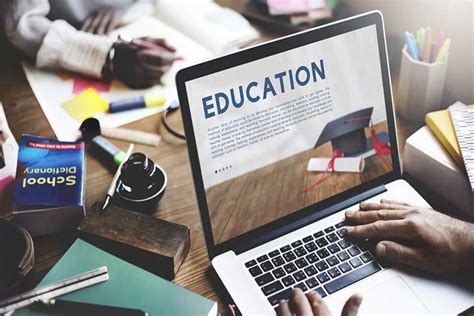Are you looking to transform the way education is delivered and experienced? Look no further than these 10 must-have educational technologies that are revolutionizing the way we learn and teach. From interactive whiteboards that completely transform classroom learning to mobile apps that empower learning on the go, these technologies are enhancing student engagement, personalizing education, and breaking physical barriers to learning. In this blog post, we will explore the impact of interactive whiteboards, augmented reality, gamification, adaptive learning, mobile apps, virtual reality, artificial intelligence, online learning platforms, digital assessment tools, and collaborative tools on education. Join us as we delve into how these technologies are shaping the future of education and find out how they can benefit both students and educators alike. Whether you’re a teacher looking to enhance your classroom or a student wanting to make learning more engaging, these educational technologies are a game-changer.
Table of Contents
Interactive Whiteboards: Transforming Classroom Learning
Interactive Whiteboards have revolutionized the way teachers engage with students in the classroom. These smart boards are a game-changer, providing a dynamic and interactive learning experience for students of all ages. With the use of touch technology, teachers can easily navigate through lessons, and students can interact with the content at their own pace.
Furthermore, interactive whiteboards have the ability to integrate multimedia elements such as videos, images, and audio, enhancing the overall learning experience. This multisensory approach helps students better understand and retain information, making classroom learning more effective and engaging.
Another benefit of interactive whiteboards is the ability for teachers to personalize lessons to meet the diverse needs of their students. The flexibility of the technology allows for a variety of teaching methods to be employed, catering to different learning styles and abilities. This personalized approach to education promotes inclusivity and ensures that every student has the opportunity to succeed.
In conclusion, interactive whiteboards have transformed classroom learning by providing a more interactive, dynamic, and personalized educational experience. With the integration of multimedia elements and personalized teaching methods, these smart boards have proven to be an effective tool in enhancing student engagement and understanding.
Augmented Reality: Enhancing Student Engagement and Understanding
Augmented Reality (AR) has emerged as a powerful tool in education, revolutionizing the way students learn and engage with the material. By superimposing digital content onto the real world, AR takes learning to a whole new level, making it more interactive and immersive.
One of the main benefits of AR in education is its ability to enhance student engagement. Instead of passively consuming information, students can actively participate in their learning by interacting with 3D models, animations, and simulations. This hands-on approach not only captures their attention but also helps them better understand and retain the material.
Furthermore, AR can make abstract concepts more tangible and easier to comprehend. For example, students studying anatomy can use AR apps to visualize and explore the human body in 3D, gaining a deeper understanding of its structure and function. This visual aid can significantly improve their grasp of complex topics.
Another advantage of AR is its potential to cater to different learning styles. Visual and kinesthetic learners, in particular, can benefit greatly from the multi-sensory experience that AR offers. By providing a more personalized and dynamic learning environment, AR can accommodate diverse student needs and preferences.
Gamification: Making Learning Fun and Effective
When it comes to education, making learning fun and effective should always be a top priority. One way to achieve this is through the use of gamification. This innovative approach to learning incorporates game elements and design principles into educational activities, making the learning process more engaging and enjoyable for students.
Gamification involves using elements such as points, badges, leaderboards, and rewards to motivate students to actively participate in their learning. By incorporating these elements into lessons and assignments, educators can create a more interactive and competitive learning environment that encourages students to strive for success.
Furthermore, gamification can also make learning more effective by providing instant feedback and recognition for students’ accomplishments. This instant feedback loop helps students to track their progress and understand their strengths and weaknesses, leading to greater learning outcomes.
In conclusion, gamification is a powerful tool for making learning fun and effective. By incorporating game elements into educational activities, educators can create a more engaging and rewarding learning experience for students, ultimately leading to improved learning outcomes.
Adaptive Learning: Personalizing Education for Every Student
Adaptive learning is a method of teaching and learning that uses technology and data to cater to the unique needs of each student. This personalized approach to education allows students to work at their own pace and receive individualized support and feedback.
By using adaptive learning systems, educators can create custom learning paths for students based on their strengths, weaknesses, and learning styles. This can lead to improved academic performance and increased engagement in the classroom.
One of the key benefits of adaptive learning is that it allows students to take control of their own learning. They can set their own learning goals and track their progress, which can result in a greater sense of ownership and responsibility for their education.
In addition, adaptive learning technology can provide teachers with valuable insights into each student’s learning process, allowing them to better support and guide their students towards success.
Mobile Apps: Empowering Learning on the Go
In today’s fast-paced world, learning doesn’t have to be confined to the walls of a classroom. With the advent of mobile apps, students can now take their education with them wherever they go, empowering them to learn on the go.
Whether it’s a math problem that needs solving, a new language to be practiced, or a history lesson to be revised, there is an app for every subject and every level of education. These mobile apps provide students with the flexibility to learn at their own pace, in their own time, and in a way that suits their individual learning style.
Furthermore, mobile apps also empower educators to create engaging and interactive learning experiences for their students. By leveraging the capabilities of mobile technology, teachers can deliver lessons in a more immersive and dynamic way, making learning more effective and enjoyable for their students.
With the power of mobile apps at their fingertips, students and educators alike are no longer bound by traditional learning constraints. Instead, they have the freedom to embrace education in a more flexible, accessible, and empowering way, wherever they may be.
Virtual Reality: Opening Doors to Immersive educational Experiences
Virtual Reality (VR) has revolutionized the way education is delivered, opening doors to immersive and interactive experiences for students of all ages. With VR technology, students are able to explore historical landmarks, dissect virtual organisms, and travel to far-off places without ever leaving the classroom.
VR is enhancing the learning experience by providing a level of engagement and understanding that traditional methods cannot match. Students are no longer confined to textbooks and lectures – they are able to interact with the subject matter in a way that feels incredibly real, making the learning process more exciting and effective.
Furthermore, VR is breaking down barriers to education by providing equal opportunities for all students. Those who may not have the means to travel to certain locations or experience certain phenomena are now able to do so through VR, ensuring that every student has access to the same educational resources.
In conclusion, VR is truly opening doors to immersive educational experiences, transforming the way students learn and engage with the world around them. As VR technology continues to advance, the possibilities for education are endless, and the impact on student learning is undeniable.
Artificial Intelligence: Revolutionizing Education with Smart Tutoring
Artificial Intelligence (AI) has completely transformed the education landscape with its innovative smart tutoring systems. These systems use AI algorithms to provide personalized learning experiences to students, catering to their individual needs and learning styles.
Through the use of AI, smart tutoring can adapt to each student’s progress and provide targeted support in areas where they may be struggling. This level of personalized education is revolutionizing the traditional one-size-fits-all approach, making learning more effective and engaging for students.
Furthermore, AI is also able to analyze vast amounts of student data to identify patterns and trends, which can inform educators’ teaching strategies and curriculum development. This data-driven approach leads to more efficient and impactful education practices, enhancing student outcomes and overall educational quality.
With the integration of AI in education, the future of smart tutoring looks promising, offering endless possibilities for personalized, effective, and revolutionized learning experiences.
Online Learning Platforms: Breaking Physical Barriers to Education
Online learning platforms have revolutionized the way education is delivered, breaking physical barriers and making learning accessible to a wider audience. With the advancement of technology, students can now access educational materials and resources from anywhere in the world, as long as they have an internet connection.
These platforms offer a wide range of courses, from academic subjects to professional development, allowing students to tailor their learning experience to their specific needs and interests. This flexibility is especially beneficial for those who may not have access to traditional educational institutions due to geographical or physical constraints.
Furthermore, online learning platforms provide opportunities for non-traditional students, such as working adults and stay-at-home parents, to pursue their education without having to sacrifice their other responsibilities. This flexibility in scheduling and accessibility can make a significant impact on the educational attainment of individuals who may have otherwise been excluded from the traditional education system.
By breaking physical barriers to education, online learning platforms are not only expanding access to knowledge and skills but also fostering a culture of lifelong learning and personal growth. With the ability to learn anytime, anywhere, individuals are empowered to take control of their own learning journey and pursue their passions and goals.
Digital Assessment Tools: Providing Instant Feedback and Evaluation
Digital assessment tools have revolutionized the way educators evaluate student performance. With the use of digital assessment tools, teachers can provide instant feedback to their students, allowing for a more personalized learning experience. These tools have the capability to streamline the evaluation process, making it more efficient and effective.
One of the key benefits of using digital assessment tools is the ability to provide instant feedback to students. This feedback can be in the form of real-time comments, suggestions, or corrections, helping students understand their mistakes and learn from them. The instant feedback also enables teachers to identify areas where students may be struggling and provide additional support as needed.
Another advantage of digital assessment tools is the ability to track student progress over time. These tools can generate detailed reports and analytics, allowing teachers to identify trends and patterns in student performance. This data can be used to tailor instruction to meet the individual needs of each student, leading to improved learning outcomes.
Furthermore, digital assessment tools provide a more efficient way of evaluating student work. With the use of automated grading and scoring, teachers can save time on manual assessment tasks and focus on providing meaningful feedback to their students. This not only benefits the teachers but also allows students to receive feedback in a timely manner, without having to wait for lengthy grading periods.
Collaborative Tools: Fostering Communication and Teamwork in Education
Collaboration in education has become increasingly important in today’s digital age, where communication and teamwork are essential skills for success in the workplace. As technology continues to evolve, collaborative tools are playing a crucial role in fostering communication and teamwork in educational settings.
One of the key benefits of using collaborative tools in education is that they enable students to work together on projects and assignments, regardless of their physical location. This not only promotes communication and teamwork but also allows for a more inclusive learning environment, where all students have the opportunity to contribute and collaborate.
Furthermore, collaborative tools can help students develop valuable 21st-century skills such as critical thinking, problem-solving, and creativity. By working together on projects, students learn to communicate effectively, share ideas, and consider different perspectives, all of which are essential skills for success in the modern workplace.
Overall, the use of collaborative tools in education has the potential to transform the way students learn and work together, fostering communication and teamwork in a way that prepares them for success in the digital age.





